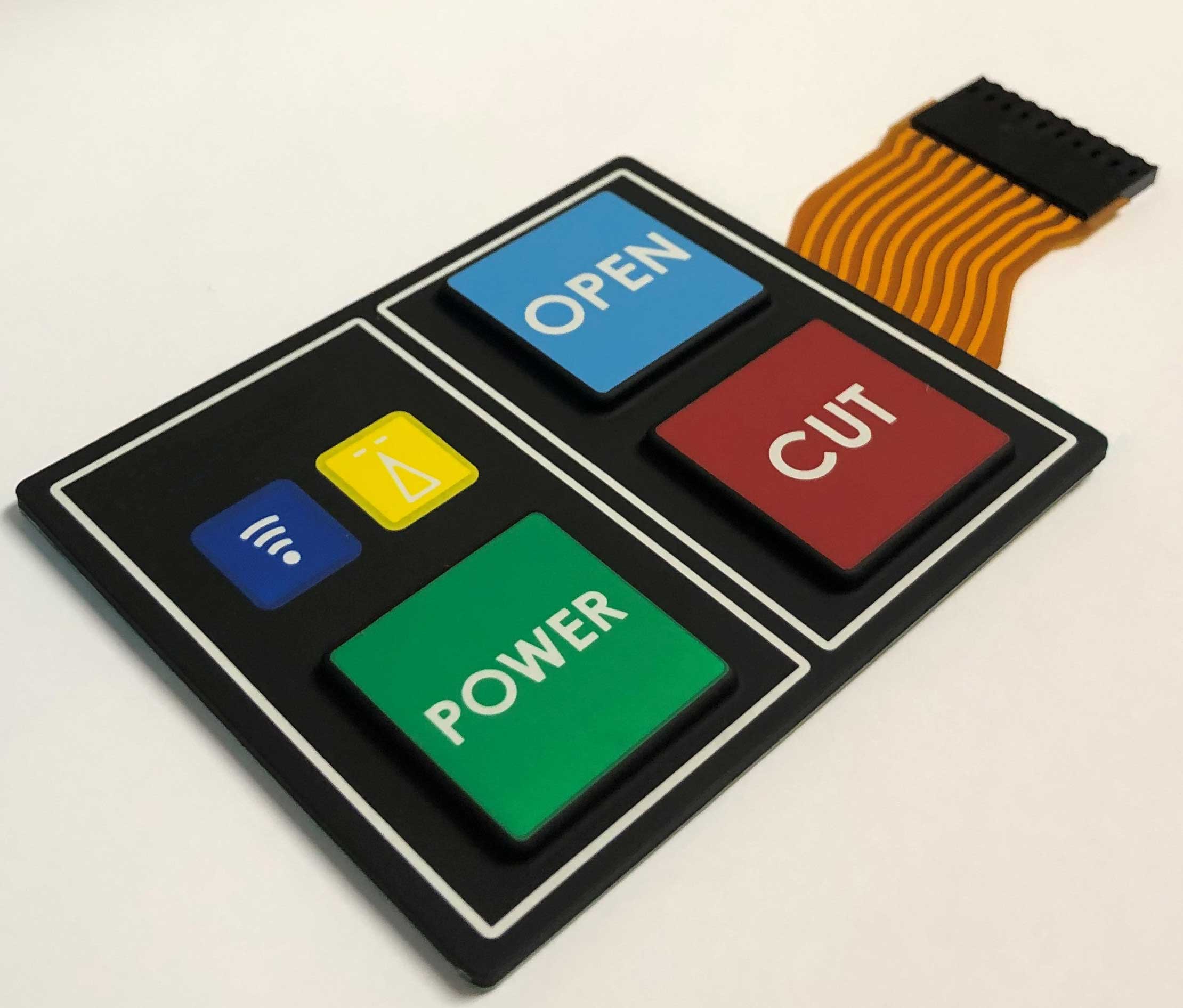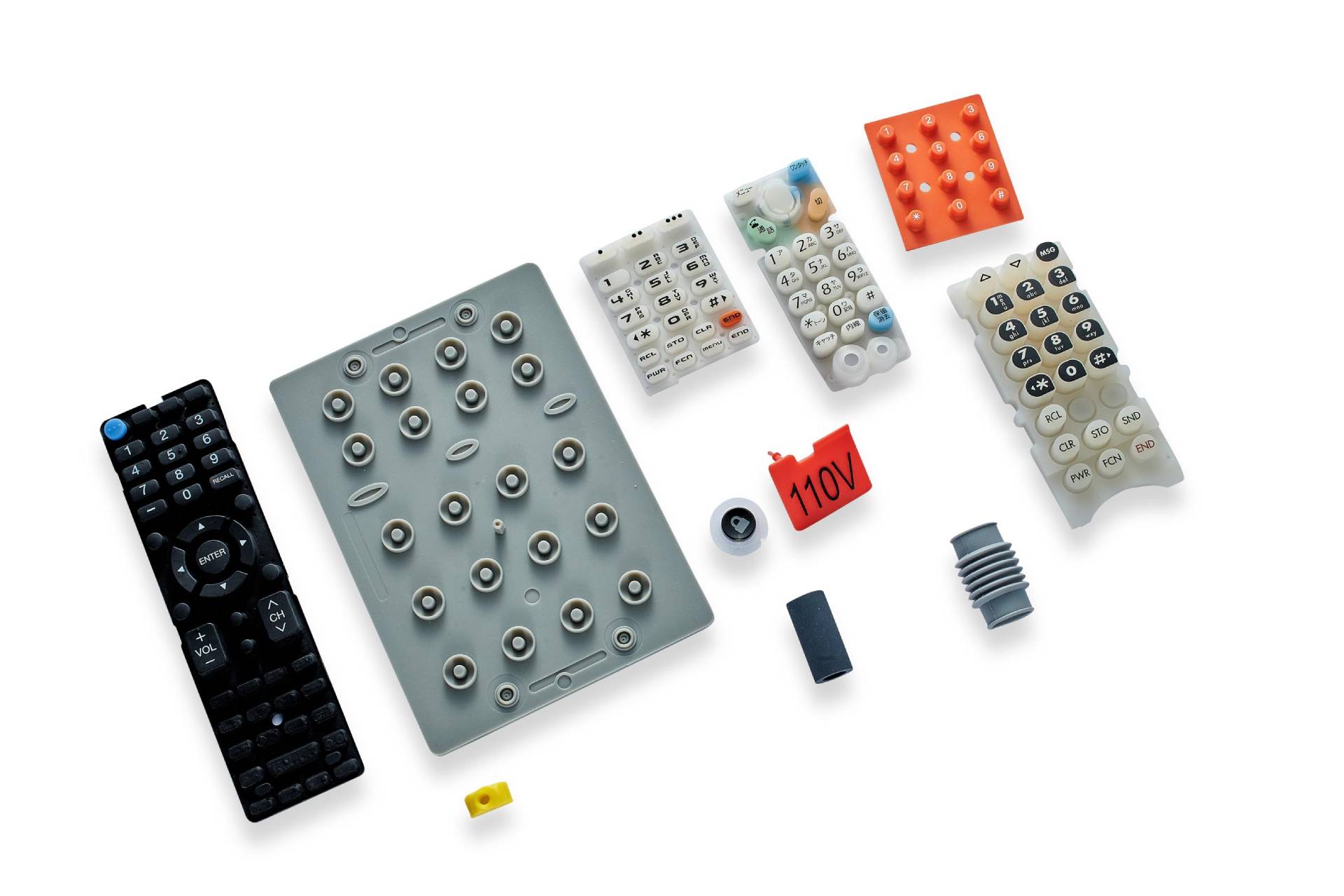7 major reasons of using premium Rubber Keypads in consumer electronics
Wiki Article
A Comprehensive Guide to the Production and Processing of Rubber Keypads for Optimal Performance
The production and processing of rubber keypads play a vital function in their performance and use. Product option, layout accuracy, and innovative production techniques considerably impact their durability and performance. Recognizing these aspects is essential for producing premium products. As different developments arise in this field, discovering their effects could reveal brand-new standards for functionality and customer experience. What vital elements will shape the future of rubber keypads?Comprehending Rubber Keypads: Products and Types
Rubber keypads are crucial components in numerous devices, providing an equilibrium of resilience and responsive responses. These keypads are largely made from silicone or artificial rubber, materials picked for their adaptability and strength. Silicone rubber, in particular, is preferred for its superb temperature resistance and longevity, making it perfect for numerous applications, from consumer electronics to industrial equipment.There are several kinds of rubber keypads, consisting of dome button keypads, which make use of a dome-shaped system that provides responsive feedback when pushed. Additionally, there are also level keypads, which feature a smooth surface area and are commonly used in medical devices and remote controls. The selection of material and kind affects the keypad's efficiency, feel, and overall user experience. Recognizing these facets is crucial for developers and producers aiming to produce efficient and trusted user interfaces in their products.
The Manufacturing Process: From Style to Manufacturing
The production procedure of rubber keypads involves numerous essential stages, beginning with style and ending with manufacturing. Developers produce in-depth specs and models, assuring the keypad satisfies useful and visual demands. Computer-aided style (CAD) software application is commonly utilized to envision the format and features before proceeding.Once the design is completed, product choice is crucial, with choices commonly consisting of silicone or natural rubber. In the following stage, molds are produced based upon the approved layouts, which will certainly form the keypads throughout manufacturing.
Complying with mold and mildew development, the production phase starts, where rubber is blended with additives to boost performance. The blend is then put right into mold and mildews and based on heat and stress, allowing it to heal and solidify.
The finished keypads undertake high quality checks to verify they meet recognized criteria, followed by packaging for distribution. This comprehensive process guarantees peak performance in the last product.
Secret Methods in Rubber Molding
In the domain of rubber keypads, various molding strategies play a crucial role in determining the quality and capability of the final item. One widespread technique is compression molding, where raw rubber is positioned in a warmed mold and mildew and stress is used, permitting for reliable mass production and harmony. An additional substantial technique is injection molding, which involves injecting heated rubber right into a mold and mildew, offering higher accuracy and facility forms. Transfer molding, a hybrid of both techniques, is additionally made use of, particularly for intricate styles, as it combines the benefits of both processes. In addition, liquid silicone rubber (LSR) molding is getting traction as a result of its adaptability and longevity, making it excellent for high-performance applications. Each technique possesses unique features, influencing factors such as cycle time, material waste, and manufacturing prices. Selecting the ideal molding strategy is essential for attaining peak performance in rubber keypads.Surface Area Finishing and Texturing Options
Surface area ending up and texturing alternatives play an essential duty in improving the responsive experience and visual appeal of rubber keypads. Manufacturers utilize different methods to create unique surface qualities that impact user communication and item design. Common completing approaches include matte, glossy, and satin finishes, each using various visual effects and grip degrees. Texturing choices, such as elevated patterns, grooves, or stippling, further improve capability by boosting grip and decreasing slippage during usage.Additionally, details appearances can be tailored to meet ergonomic needs, offering convenience throughout prolonged use. The selection of surface finishes and appearances can be affected by the designated application of the keypad, whether it be for consumer electronics, automotive controls, or commercial gadgets. Eventually, mindful factor to consider of these alternatives adds greatly to user fulfillment and overall item performance, making them essential elements in the style and manufacturing process of rubber keypads.
Quality Assurance Measures in Rubber Keypad Manufacturing
Quality assurance steps in rubber keypad production are crucial for guaranteeing product dependability and efficiency. These measures include product option criteria, strenuous testing treatments, and rigorous last examination criteria. With each other, they Recommended Site develop an extensive structure that assists manufacturers copyright high quality throughout the manufacturing process.Material Option Criteria
Choosing the suitable products for rubber keypads is check it out important, as it straight impacts their customer, capability, and sturdiness experience. Trick standards for product selection consist of tensile strength, strength, and environmental resistance. The selection of rubber compound, such as silicone or thermoplastic elastomer (TPE), plays a crucial duty in accomplishing preferred tactile comments and longevity. Furthermore, factors like chemical compatibility, temperature level security, and UV resistance must be considered to ensure maximum efficiency in numerous applications. Producers ought to additionally examine the convenience of handling and cost-effectiveness of products, stabilizing high quality with spending plan constraints. Eventually, the appropriate product option not just improves the keypad's performance but likewise contributes to overall product top quality and consumer satisfaction.Testing Treatments Applied
After figuring out the proper materials for rubber keypads, strenuous screening treatments are implemented to confirm that the end products satisfy sector standards and consumer expectations. These treatments generally include mechanical testing, which evaluates the sturdiness and elasticity of the rubber under different conditions. Furthermore, ecological screening evaluates the keypads' performance under temperature level variations, humidity, and direct exposure to chemicals. Electric screening verifies the keypads work appropriately with digital parts, validating responsiveness and conductivity. Additionally, tactile responses is assessed to ensure individual contentment. These considerable screening steps are important in determining any type of variances or flaws prior to automation, ultimately improving the reliability and efficiency of rubber keypads in their desired applications.
Last Evaluation Specifications
Comprehensive final inspection requirements are important in rubber keypad production to guarantee that each unit fulfills the specified standards for performance and look. This procedure normally entails aesthetic assessments to identify any surface issues, such as discoloration or blemishes. In addition, responsive assessments establish that the keypads react properly to touch, preserving the needed degree of sensitivity. Longevity examinations might likewise be performed, replicating prolonged use to verify the longevity of the keypad under different problems. Additionally, adherence to market guidelines and client specifications is confirmed to keep quality control. By applying these rigorous examination steps, makers can significantly decrease the risk of issues, ensuring that the end product is trustworthy and satisfies customer expectations, eventually boosting consumer fulfillment.Developments in Rubber Keypad Technology
As modern technology remains to evolve, advancements in rubber keypad technology are improving customer interfaces throughout various sectors. One considerable development is the combination of capacitive touch sensors within rubber keypads, permitting a much more functional and responsive like it customer experience. This innovation makes it possible for individuals to communicate with devices through touch, improving functionality without compromising the responsive comments that rubber keypads are understood for.Additionally, enhancements in material formulations have brought about the advancement of even more long lasting, weather-resistant rubber, making keypads suitable for outside and industrial use. Boosted printing methods also permit high-resolution graphics and backlighting options, boosting exposure and visual appeal.

Additionally, improvements in making processes, such as 3D printing, are enabling custom-made layouts and rapid prototyping, simplifying production timelines. These developments jointly contribute to much more straightforward and efficient rubber keypads, guaranteeing they satisfy the demands of modern-day applications while maintaining their core benefits.
Best Practices for Style and Performance
Designing reliable rubber keypads requires careful examination of both visual appeals and capability. Rubber Keypads. A well-designed keypad should stabilize ergonomic principles with visual interest improve user experience. Secret factors include dimension, shape, and spacing of switches, ensuring they are easy to press while protecting against unintentional activation. Making use of contrasting colors and textures can boost presence and responsive responses, assisting users in comparing tricksIn addition, the choice of products plays an important function; premium rubber substances can enhance sturdiness and resistance to wear. It is likewise vital to take into consideration the integration of functions such as backlighting and personalized graphics, which can improve usability in different settings.
Prototyping and user screening are indispensable in the layout procedure, allowing for changes based on real-world comments. By sticking to these best practices, manufacturers can create rubber keypads that not only look enticing but also meet the functional demands of individuals successfully.
Often Asked Questions
How Do I Select the Right Rubber Product for My Keypad?
To select the best rubber product for a keypad, one ought to take into consideration aspects such as longevity, ecological resistance, tactile comments, and compatibility with the intended application, making certain perfect efficiency and individual complete satisfaction in numerous problems.What Are the Environmental Effects of Rubber Keypad Production?
Rubber keypad manufacturing can lead to environmental impacts such as deforestation for natural rubber resources, air pollution from chemical processes, and waste generation. Sustainable techniques and materials can alleviate several of these adverse impacts on ecological communities.Can Rubber Keypads Be Recycled or Recycled?
Rubber keypads can be reused, however the procedure depends upon the specific products made use of in their production. Recycling them in various applications is likewise possible, adding to throw away reduction and advertising sustainability in making methods.What Is the Typical Lifespan of a Rubber Keypad?
The ordinary lifespan of a rubber keypad usually varies from 5 to ten years, relying on use, environmental variables, and upkeep. Regular treatment can extend its functionality, while too much wear might reduce its sturdiness.Exist Any Type Of Wellness Concerns Associated With Rubber Keypad Materials?
There are possible health and wellness concerns connected to rubber keypad materials, including allergies to specific chemicals and irritants utilized in production. Correct handling and recognition of material composition can reduce these risks for individuals.There are a number of kinds of rubber keypads, including dome button keypads, which make use of a dome-shaped device that gives tactile feedback when pushed. Selecting the proper materials for rubber keypads is important, as it straight affects their performance, user, and durability experience - Rubber Keypads. After identifying the proper materials for rubber keypads, extensive testing treatments are applied to verify that the last items fulfill market requirements and customer expectations. Rubber keypad manufacturing can lead to ecological impacts such as logging for all-natural rubber resources, pollution from chemical procedures, and waste generation. Rubber keypads can be reused, yet the process depends on the certain products utilized in their production
Report this wiki page